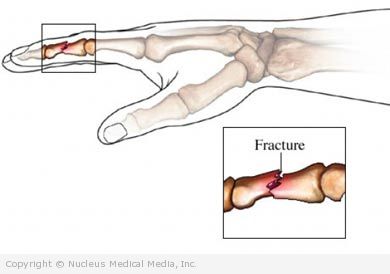Finger fracture
(Broken Finger)
Finger fracture – Definition
A finger fracture is a break in any of the bones in a finger. Each finger consists of three bones called the phalanges. The thumb has only two phalanges.
Finger fracture – Causes
A finger fracture is caused by trauma to the finger. Trauma includes:
- Falls
- Blows
- Collisions
- Severe twists
Finger fracture – Risk Factors
A risk factor is something that increases your chance of getting an injury.
General risk factors for fractures include:
- Advancing age
- Postmenopause
- Osteoporosis
- Poor nutrition
- Certain congenital bone conditions
- Participating in contact sports
- Violence
Finger fracture – Symptoms
Symptoms include:
- Pain, often severe
- Swelling and tenderness
- Inability to move finger well without pain or difficulty moving finger
- Possible deformity at fracture site
Finger fracture – Diagnosis
The doctor will ask about your symptoms, your physical activity, and how the injury occurred. The injured finger will be examined. The doctor may order x-rays of the finger to determine which bones are broken and the type of fracture.
Finger fracture – Treatment
Treatment will depend on the severity of the injury. Treatment involves:
Putting the pieces of the bone back in place, which in some cases may require anesthesia and/or surgery
Keeping the pieces together while the bone heals itself
The doctor will put the bones back into place. This is usually done without surgery. However, if your fracture is severe, you may need pins, screws, or small plates to hold the bones in place. Each of these will require surgery. Pins may only require minor surgery, performed under local anesthesia.
Your finger will be put in a splint or cast to hold your finger motionless and to protect it. You will need to wear the splint or cast as long as your doctor recommends (usually 3-6 weeks). Your doctor may order x-rays during the healing time to ensure that the bones have not shifted position.
Finger fracture – Exercises
When your doctor decides you are ready, start range-of-motion and strengthening exercises. This is as important as the surgery performed. In certain situations, you may be referred to a physical therapist to assist you with these exercises.
If you are diagnosed with a finger fracture, follow your doctor’s instructions.
Finger fracture – Prevention
To help prevent finger fractures:
- Do not put yourself at risk for trauma to the fingers:
- Learn to practice correct technique in sports. Wear proper padding and safety equipment when participating in sports or physical activities.
- Eat a diet rich in calcium and vitamin D.
- Do weight-bearing and upper body-strengthening exercises to build strong bones.

